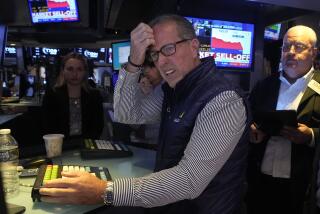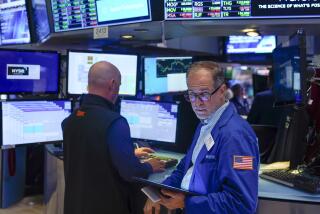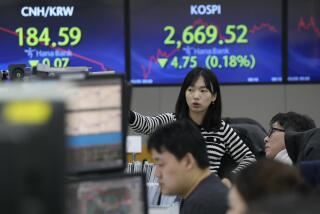Caution: Avoid Getting Burned by Hot Stocks
- Share via
If there’s any doubt left that the stock market has grabbed the general public’s attention in a major way--perhaps more so than at any time in the last 20 years--this may put it to rest:
* Item: Turner Broadcasting, parent of the ubiquitous Cable News Network, has begun running ads on CNN touting Turner stock to viewers. “There’s a lot of talk today about growth companies,” the ads begin. They then go on to explain Turner’s growth record, and end by noting that the stock is listed on the American Stock Exchange.
* Item: Jeffrey Malet, manager of the $180-million Pacific Horizon Aggressive Growth stock mutual fund in La Jolla, was shocked to discover that his 70-year-old mother has been discussing biotechnology stocks with her friends.
* Item: Fidelity Investments, the nation’s biggest mutual fund company, announced Friday that it will extend hours at its walk-in investor centers nationwide because of a surge in business. Fidelity’s L.A. offices, which had been open from 8 a.m. to 4:30 p.m., will now open at 6:30 a.m. and close at 6:30 p.m.
Even non-investors know that stocks are hot, of course. With interest rates at 27-year lows and real estate prices flat or falling, investors have been pouring into the stock market for almost a year in search of better returns. With each rally--including the latest, which has lifted the Dow Jones industrial average from 2,850 in mid-December to 3,200 as of Friday--the individual investor’s need to own stocks has mushroomed.
But a trillion-dollar question is weighing heavily on Wall Street as investors flood into the market: Where does investment end--and blatant, ruinous speculation begin?
For clues, many experts are watching a select group of stocks that have come to captivate small and large investors alike since 1989: The “growth” stocks, companies whose sales and earnings are expected to grow at a dramatic pace in the 1990s.
Throughout Wall Street history, growth-stock manias have come and gone. But many market veterans say the current growth-stock craze is unquestionably the wildest since two buying panics that often fuse together in Wall Street’s collective memory--the frenzies of 1968 and 1972.
By looking back, analysts are trying to judge the longevity of the current mania.
* In 1968, stocks of many small high-technology companies of the day reached their zenith, after surging for much of the 1960s. Bradlee Perry, the 64-year-old chairman of the Babson Mutual Funds in Boston, remembers that decade as “the first active market in small-company stocks. It was the dawn of the electronic age.”
In that era, Xerox Corp. became the symbol of limitless new technology. And by late 1968 and early 1969, investors had bid other alleged “new technology” stocks to prices that were 50 times or greater the companies’ annual earnings per share. Cocktail party chatter revolved around stocks, Perry remembers, as individual investors surged into the market. “Everyone was looking for ‘the next Xerox,’ ” he recalls.
But when the market frenzy finally ended early in 1969--for reasons still debated--many of the highflying stocks abruptly crashed. The Dow Jones industrial average plunged from 1,000 early in ’69 to 650 by mid-1970, a 35% drop. And many of the “future Xeroxes” suffered worse fates, as it became clear that their growth would never live up to expectations.
* By 1972, a new frenzy had overtaken Wall Street. The technology craze was largely left behind. The growth-stock stars of 1972 were the greatest consumer products companies of the day--Sony, McDonald’s, Avon Products, Clorox and others. As the nation’s baby boomers began to come of age and the consumer society burgeoned, the companies that served those consumers were viewed as having limitless growth potential.
So money poured into the stocks, pushing their prices to astronomical levels. As with the technology stocks four years earlier, investors were willing to pay 50 times or greater price-to-earnings ratios for the consumer-stock stars.
Once again, the outcome was disaster: The market peaked early in 1973 at about 1,050 on the Dow, then plunged into a bear market that didn’t end until December, 1974, with the Dow at about 580, a 45% decline. For Avon, Eastman Kodak, Polaroid and other leaders of the day, their stocks would never again come close to the peak prices of 1972.
The key barometer in both the 1968 and 1972 growth-stock manias was the price-to-earnings ratio, or P-E. It’s a simple measure of investor enthusiasm, because it shows how high a price investors are willing to pay for $1 worth of corporate earnings. If a company earned $1 a share last year, and its stock sells for $20, the P-E is 20. If the stock zooms to $50, the P-E is 50 until earnings catch up.
Generally, investors are willing to pay higher P-Es for stocks whose earnings are growing rapidly. But historically, the average stock’s P-E has been in the 10 to 20 range.
When the growth stocks of the day begin to top the 50 P-E mark--as they did in 1968 and 1972--warning signs flash.
That’s what is troubling many Wall Streeters today: Health care stocks, the new growth gods, have been soaring for two years and now sport P-Es in the stratosphere.
ALZA Corp., a premier drug research firm, now sells for $53.25 a share, or about 108 times its 1991 earnings, estimated at 50 cents a share. U.S. Surgical, which has revolutionized the market for surgical stapling devices, sells for about 84 times 1991 earnings.
Outside health care, a handful of other growth stocks also have skyrocketed. Retailer Home Depot sells for 58 times earnings. Computer networker Novell is at 57 times; slot-machine manufacturer International Game Technology is at 43 times.
Veteran money manager James Gipson of Pacific Financial Research in Beverly Hills looks at those price-to-earnings multiples and says simply, “Growth stocks are overvalued.”
Even the Pacific Horizon fund’s Malet, who steered his fund to a stunning 71% gain last year by owning many of the favorite growth stocks, admits that he wouldn’t buy a high-flyer like U.S. Surgical at its current P-E ratio (though he still holds the shares from earlier purchases).
Why do so many other investors keep flocking to such stocks, even though their valuations have reached Never-Never Land?
The buyers have a million ways to justify their decisions: Hot stocks stay hot for a long time; interest rates are low, which automatically makes growth-stock earnings more valuable; the stocks’ future P-Es aren’t really high if the companies’ earnings grow at the expected 35% to 50% annual rates; the markets these firms serve have gigantic growth potential.
But no matter how well a company delivers on its earnings promises, trees don’t grow to the sky and neither do stocks. There has to be a limit on how high a price a rational investor is willing to pay for growth stocks. That was the lesson of 1968 and 1972.
Given the P-E ratios of the highest-flying stocks today, it’s clear to most veteran investors that the top-tier of growth stocks no longer represents investment, but rather dangerous speculation.
The question is what that means for the stock market as a whole.
Malet argues that “just because a few stocks are overpriced doesn’t mean they all are.” He believes that the market’s favorite growth stocks are signaling only their own special brand of speculation, and that the majority of stocks still have a long way to run if interest rates remain low and individual investors continue to look to stocks as the only logical alternative.
Gipson, who manages $2 billion, agrees that the problem of outrageous valuation remains centered on a relative few market darlings, and that the majority of stocks “are somewhere between fairly valued and a little cheap.”
If they’re right, individual investors who are willing to buy into the market slowly in 1992, and via a diversified portfolio such as a mutual fund, can do so with healthy expectations of a long-term payoff.
But for those who still are desperate to jump into the hottest of the growth stocks, the risks now are beyond extreme. Says Babson’s Perry: “Whenever you feel you have to own a stock, it’s probably too late.”
What Price Growth?
As stock prices climb--particularly--prices of the “growth-company” stocks that are the market’s darlings--many investors wonder how high is too high. Here’s a look at the price-to-earnings ratios that some growth stocks reached at their peaks in 1972--during the last big growth-stock craze--and the ratios for some of today’s favorite stocks.
Price-to-earnings ratios (stock price divided by prior 12 months’ earnings per share): 1972:
Sony: 92
McDonald’s: 83
Intl. Flavors & Fragrances: 81
Disney: 76
Avon Products: 64
Standard Brands Paint: 53
Clorox: 49
Fluor: 49
1992:
ALZA Corp.: 108
U.S. Surgical: 84
Surgical Care Affiliates: 79
Stryker Corp.: 75
Bionet: 72
Home Depot: 58
Novell Inc.: 57
Intl. Game Technology: 43
Source: Kidder, Peabody & Co.


